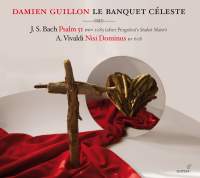Texte paru dans: / Appeared in: |
|
| "Highly recommended" |
Outil de traduction ~ (Très approximatif) |
|
Reviewer: Bertil
van Boer It is well known that Johann Sebastian Bach knew and admired the music of his contemporary Antonio Vivaldi, even arranging violin concertos for the harpsichord. What is less known is how familiar he was with other Italians of that age; certainly he was able to improvise on music by Archangelo Corelli and Tomaso Albinoni during his early career, but works in the new galant style were not entirely his cup of tea. That is, they weren’t apparently up until the last decade of his life, when one piece in particular, the Stabat mater by Giovanni Pergolesi, composed in 1736, began to be popular throughout Europe. Even in Protestant Europe, this piece became somewhat celebratory, for by 1740 copies were being produced in as faraway places as Stockholm. So, it is not surprising that Bach may have come across it, and in 1946 a mention was made that he had in fact created a parody or contrafactum. This has reappeared as a sort of Psalm setting in multiple movements with a text “Tilge, Höchster, meine Sünden.” What the German composer did was to adapt Pergolesi’s work, expanding it by rewriting the inner parts (the viola in particular), recontouring the vocal lines to accommodate the German text, and switching around a couple of the movements to make the music fit the new text’s mood better. The result is still Pergolesi, but with a Bachian twist. For instance, the penultimate movement here, “Laß dein Sion,” originally was the “Inflammatus” and came much earlier in the original; here it is interposed between the final two movements of the Pergolesi, the “Quando corpus” and the Amen fugal finale. The result of this is a work that is thickly textured and powerful, representing as it does the revisions undertaken by a master who was capable of understanding and adapting a thoroughly modern work of that time without making it an anachronism or disturbing the original musical content that had made it such a popular work of its time. The Psalm itself is too short to comprise an entire disc, and therefore the director and countertenor solo Damien Guillon has added Vivaldi’s Nisi Dominus, a favorite of altos forever, it seems. The choice is not so far-fetched, given that there is a stylistic similarity between the two works (Pergolesi and Vivaldi, not to mention Bach’s admiration of the latter). In terms
of the performance, this is perhaps the first of Bach’s adaptation that I
know of offhand. Soprano Céline Scheen has a clear and very powerful voice
that complements the flexible and sonorous countertenor of Damien Guillon
quite well. Given that the work, Bach adaptation or not, is still quite
Italian, the quality needs to be quite full and not like the clarity
required of the normal German cantata. Scheen and Guillon provide just that
richness in tone and depth that is required for the music (the latter also
being an excellent interpreter of the Vivaldi). The period instrument
ensemble performs mainly one on a part, though of course there is a thicker
continuo with lute, bass strings, and harpsichord anchoring the group. It
is, however, not bottom heavy, but precise and able to thicken the texture
(as Bach often requires it) or lighten it at will. The tempos are all nicely
flowing and variable according to the needs of the music, and I found no
problems with intonation at all. The sound is quite resonant. This is a fine
disc, and one that gives us another look at Bach, who, far from being caught
up in his own anachronistic style, was able to take a piece that was
stylistically different and adapt it easily and successfully so that it
found use outside its original Catholic liturgical intent. The Vivaldi work
is just icing on this German musical cake. This disc comes highly
recommended. | |
|
|
|
|
Cliquez l'un ou l'autre
bouton pour découvrir bien d'autres critiques de CD |
|




